 North Wing - Early Mississippi - Mostly Battery Sets |
| RuralMississippi: the case for Battery Operated Radios |
Electrificationdidn't become common in rural Mississippi until mid century - and telephonesfollowed much later - party lines were common into the 70's -- if a linewas available at all. Radio became a very important part of the farmerslife - providing news, weather, crop and market information -- and of courseentertainment. So there were a great many battery operated sets sold throughoutrural Mississippi - to the farmers and other wealthy folks who could affordthem. Mississippi's urban population was divided along economic lines -the largest segment of population were workers making a humble living -while a much smaller population segment had a fair amount of disposableincome and could afford a luxury of a radio Consequently the number of "electric"(AC Mains) operated sets sold were far fewer than the number of batterysets. And while there were occasional purchases by wealthy families of atruly "luxury" set - far and wide - the average radio sold inMississippi was more of the economy class. In the museum - we have severalbattery radios (and a few "were" sets) that are typical examplesof the types of radios common in Mississippi between 1920 and 1950. |
The two radios presented here both came from the L. P. Tate Homestead andFarm in Winston County. They were purchased at the estate auction in 1992- along with two other radios - a Silvertone Multi-band battery/AC set -and the Ti-Nee-Ra-Di-O crystal set shown below. As typical of radios usedon the rural Mississippi farm, none required AC Mains power. Unfortunately,these two radios had been stored in an out building - and both sufferedsevere water damage. 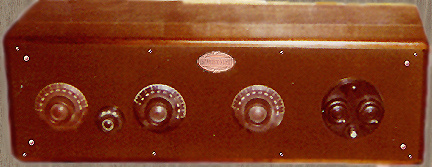 The Atwater Kent Model 20 Big Box (1924) survivedin better shape - though the glue in the joints had totally failed - thesolid wood of it's Mahogany case survived and has been restored to it'soriginal beauty. The metal panel suffered severe rust damage - but was ableto be refinished. Fortunately - the internal parts suffered no unusual damage- though as is very common with this model set - the audio transformerswere both bad. Another unusual thing about this radio - all of the frontpanel hardware is either copper or copper plated - even the Atwater KentBadge - which is usually brass or gold plated - is solid copper. This softrosy copper color blends and compliments the brown crinkle finish of thefront panel. The Atwater Kent Model 20 Big Box (1924) survivedin better shape - though the glue in the joints had totally failed - thesolid wood of it's Mahogany case survived and has been restored to it'soriginal beauty. The metal panel suffered severe rust damage - but was ableto be refinished. Fortunately - the internal parts suffered no unusual damage- though as is very common with this model set - the audio transformerswere both bad. Another unusual thing about this radio - all of the frontpanel hardware is either copper or copper plated - even the Atwater KentBadge - which is usually brass or gold plated - is solid copper. This softrosy copper color blends and compliments the brown crinkle finish of thefront panel. |
The Crosley Trirdyne 3-R-3 Super Special (1925) - having been made withcheaper materials - fared much worse. The cabinet is nearly a total loss- though enough remains for salvage to allow a reasonable restoration.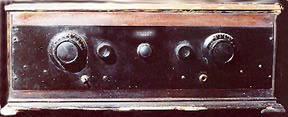  The 3-R-3 is an unusual radio in that it is a three tube Super Regenerativereceiver - and in fact an inside label notes the 1919 Armstrong Patent onthe regenerative design. Super Regenerative receivers use the principleof passing a signal through a tube multiple times to get tremendous gainout of a single tube - which allows a radio to be built with 2 or 3 tubesto perform like a 5 or 8 tube set. The down-side to this is that the "regeneration"must be constantly adjusted to match the incoming signal - too little regeneration- and you can't hear the station. Too much regeneration - and the set goesinto oscillation - making a terribly loud squeal. While less expensive thana conventional circuit - and often times capable of out-performing them- the regenerative receiver was a pain to use - and people often becameirritated with their "quirky" behavior - and replaced them withsomething much more satisfying to listen to. This is a common scenario:the Crosley would be purchased first - because of it's lower price. Aftera short while - but now thoroughly hooked on radio - the buyer was backlooking for a better set - even if it meant buying that Atwater Kent attwice the price. |
In spite of the fact that Atwater Kent Radios were expensive comparedto most other brands - many of the wealthier Mississippi families treatedthemselves to that luxury - and "suffered" the envy of their neighborsand friends. This 1925 Atwater Kent Model 21 is typical of the new verysmall parlor sets that could be made with the advent of the UX/UV199 lowpower tube (It's footprint is just over one-half that of the 20 Big Boxabove).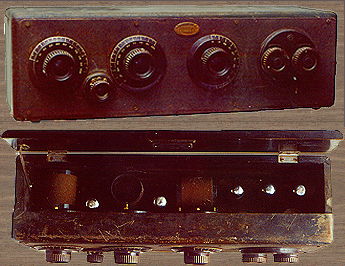 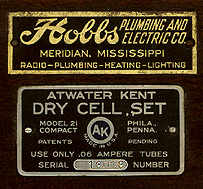 Using only .06 Amps - or 1/6 of the power of the previous 201Atubes - the radio and it's battery could now be very small. This particularradio was sold by Hobgood Plumbing and Electric Co. here in Meridian, MS.The Coals Family used it for many years - in fact Mr. G. C. Coals Sr. triedto get the radio fixed in 1955 - but it was considered not worth fixing.On the repair tag where the date of purchase is supposed to go - someonejust wrote in "OLD" Using only .06 Amps - or 1/6 of the power of the previous 201Atubes - the radio and it's battery could now be very small. This particularradio was sold by Hobgood Plumbing and Electric Co. here in Meridian, MS.The Coals Family used it for many years - in fact Mr. G. C. Coals Sr. triedto get the radio fixed in 1955 - but it was considered not worth fixing.On the repair tag where the date of purchase is supposed to go - someonejust wrote in "OLD" |
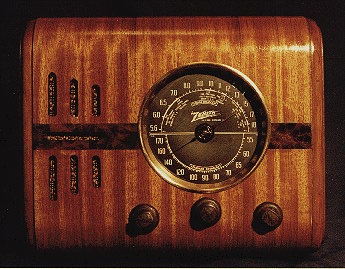 Here isa 1937 Zenith 5-F-233 set. Manufactured by Zenith as a five tube batteryset. In 1942 - new radios were extremely difficult to come by because ofthe war - so the radio repair man here in Meridian converted it to an ACset. It was then made a present to a young man for Christmas. He listenedto that radio all through school - and into his adult hood. It was tradedto a maintenance man for some work - and it served many years. Finally itwas stored away. In 1992 it once again became a Christmas present - thistime to a collector -- who restored the radio -- so it is now entering it's60th year of use in Meridian, MS. On the index page the radio is shown with a battery similar to what this radio used before it was converted to AC. Here isa 1937 Zenith 5-F-233 set. Manufactured by Zenith as a five tube batteryset. In 1942 - new radios were extremely difficult to come by because ofthe war - so the radio repair man here in Meridian converted it to an ACset. It was then made a present to a young man for Christmas. He listenedto that radio all through school - and into his adult hood. It was tradedto a maintenance man for some work - and it served many years. Finally itwas stored away. In 1992 it once again became a Christmas present - thistime to a collector -- who restored the radio -- so it is now entering it's60th year of use in Meridian, MS. On the index page the radio is shown with a battery similar to what this radio used before it was converted to AC. Speaking of batteries -- In the very early battery radios - the batteries came in two parts - the low voltage high current battery that supplied the tube's heater (filament) current - called "A" cells or A Battery. The high voltage low current battery that supplied the plate current that the tubes operated on: called "B" Cells or B Battery. To this day we still call the main supply in electronics the B+ supply... old habits and all that... Anyway - from 1900 through the late 20's - the B cells were made like flashlight batteries - with the cells connected in series to get the required B+ usually somewhere between 67 and 120 volts - with 90V being usual. Because the current draw was comparatively low (.01 to .02 amps - depending on how loud the set was run) - so the B Battery lasted quite a long time (several months or an hour or so a day). The A battery - however had anywhere from .75 to 1.5 Amps draw - a few hours - and the A battery was dead. So these were wet cells - rechargable like car batteries - large, heavy - acid spills - oops sorry about the carpet! Not real popular. By the late 30's Philco and others had perfected better cells - and coupled with new tubes whose filaments only need .05 amp at 1.5 volts - and they could actually put all of the cells - A and B cells - in a single case. 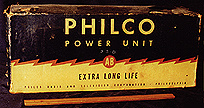 By design - under "usual" use - the very large A battery (using very large cells) would run down just about the time the B battery (using much smaller cells) would run down - then you just tossed the old battery and put in a new one. The Battery pictured here is one such battery - 60 "D" cells (series for 90V at roughly .005 to .01 amps) for B+; and 11 "L" cells (parallel for 1.5 volts at roughly .25 Amps of current) for the tube filaments (and often a push button dial lamp). At 21.5 pounds - this is no small battery (and yes that is a one foot ruler laying in front of it!). By design - under "usual" use - the very large A battery (using very large cells) would run down just about the time the B battery (using much smaller cells) would run down - then you just tossed the old battery and put in a new one. The Battery pictured here is one such battery - 60 "D" cells (series for 90V at roughly .005 to .01 amps) for B+; and 11 "L" cells (parallel for 1.5 volts at roughly .25 Amps of current) for the tube filaments (and often a push button dial lamp). At 21.5 pounds - this is no small battery (and yes that is a one foot ruler laying in front of it!). |
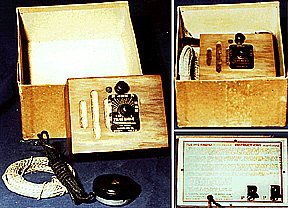 Battery sets weren't the only popular "nopower" radios in Mississippi - crystal sets had a warm place in manya heart. They could pull in those voices from the distance - and they costnothing to run. This radio was found UNDER the floor of the main house duringthe estate sale of the L. P. Tate Homestead. The war issue stamps are stilllegible on the box - and as you can see - the radio was never unpacked andused. As shipped from the factory in 1941 - this Ti- Nee-Ra-Di-O by theCarron company is typical of the sets that could be mail ordered for lessthan two dollars. Battery sets weren't the only popular "nopower" radios in Mississippi - crystal sets had a warm place in manya heart. They could pull in those voices from the distance - and they costnothing to run. This radio was found UNDER the floor of the main house duringthe estate sale of the L. P. Tate Homestead. The war issue stamps are stilllegible on the box - and as you can see - the radio was never unpacked andused. As shipped from the factory in 1941 - this Ti- Nee-Ra-Di-O by theCarron company is typical of the sets that could be mail ordered for lessthan two dollars. |
| Express to the East Wing: The tour continues... |
| Returnto the Lobby |
| Copyright © 1996, The Mississippi Historical Radio and Broadcasting Society. |